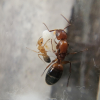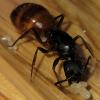- Formiculture.com
- Forums
- Gallery
- Members
- Member Map
- Chat

Brachymyrmex patagonicus nesting
Started By
Flu1d
, Apr 2 2023 11:34 AM
9 replies to this topic
#1
 Offline
-
Posted April 2 2023 - 11:34 AM
Offline
-
Posted April 2 2023 - 11:34 AM
Hello everyone, sorry I haven't been active lately. So far I still only have my S. invicta colonies and some B. patagonicus. I will be receiving Camponotus snellingi and Camponotus castaneus fairly soon, as well.
Sorry, back to the topic at hand!
I am having trouble getting a straight answer on this species.. I am told by some people that they are polygynous, and others are telling me they are only pleometrotic.
What is the verdict?
I have one queen with cocoons, however I also have a tube with 5 queens together as well that I just recently caught. Will they cull or are they truly polygynous?
Thanks!
Sorry, back to the topic at hand!
I am having trouble getting a straight answer on this species.. I am told by some people that they are polygynous, and others are telling me they are only pleometrotic.
What is the verdict?
I have one queen with cocoons, however I also have a tube with 5 queens together as well that I just recently caught. Will they cull or are they truly polygynous?
Thanks!
#2
 Offline
-
Posted April 2 2023 - 1:00 PM
Offline
-
Posted April 2 2023 - 1:00 PM
B. patagonicus are interesting in that they are monogynous in the wild, yet polygynous in captivity. We have no idea why this is but it’s what's been observed by both keepers and myrmecologists.
- AntsCali098 likes this
My journals:
Polyergus Mexicanus: https://www.formicul...gs/#entry175528
Lasius minutus: https://www.formicul...cs/#entry174811
Lasius latipes: https://www.formicul...gs/#entry206449
General acanthomyops journal: https://www.formicul...yops-with-eggs/
Polyergus Mexicanus: https://www.formicul...gs/#entry175528
Lasius minutus: https://www.formicul...cs/#entry174811
Lasius latipes: https://www.formicul...gs/#entry206449
General acanthomyops journal: https://www.formicul...yops-with-eggs/
#3
 Offline
-
Posted April 2 2023 - 1:37 PM
Offline
-
Posted April 2 2023 - 1:37 PM
B. patagonicus are interesting in that they are monogynous in the wild, yet polygynous in captivity. We have no idea why this is but it’s what's been observed by both keepers and myrmecologists.
This cannot be true. Not for the ones in Florida, at least.
#4
 Offline
-
Posted April 2 2023 - 2:15 PM
Offline
-
Posted April 2 2023 - 2:15 PM
My journals:
Polyergus Mexicanus: https://www.formicul...gs/#entry175528
Lasius minutus: https://www.formicul...cs/#entry174811
Lasius latipes: https://www.formicul...gs/#entry206449
General acanthomyops journal: https://www.formicul...yops-with-eggs/
Polyergus Mexicanus: https://www.formicul...gs/#entry175528
Lasius minutus: https://www.formicul...cs/#entry174811
Lasius latipes: https://www.formicul...gs/#entry206449
General acanthomyops journal: https://www.formicul...yops-with-eggs/
#6
 Offline
-
Posted April 4 2023 - 7:46 AM
Offline
-
Posted April 4 2023 - 7:46 AM
I'm not an expert myself, however several myrmecologists from Florida (who work at the same school that wrote that paper) are all disagreeing with that. I'm not sure why, kinda odd.. but they have other resources they're citing that disagree as well as explanations for why they also disagree. This is coming from Nolan (University of Florida) Cole (also UF) and Lord of Ants, not sure if he is a myrmecologist or just a super experienced, knowledgeable keeper but he seems to know a LOT.
Edited by Flu1d, April 4 2023 - 7:46 AM.
#7
 Offline
-
Posted April 4 2023 - 9:07 AM
Offline
-
Posted April 4 2023 - 9:07 AM
#8
 Offline
-
Posted April 4 2023 - 3:18 PM
Offline
-
Posted April 4 2023 - 3:18 PM
I have also found 2 queens in one wild colony before, I remember collecting them. They died out a while ago.
Ok, that's actually exactly what I needed to know! Thank you so much!
- rptraut and AntsCali098 like this
#9
 Offline
-
Posted April 4 2023 - 3:24 PM
Offline
-
Posted April 4 2023 - 3:24 PM
I'm not an expert myself, however several myrmecologists from Florida (who work at the same school that wrote that paper) are all disagreeing with that. I'm not sure why, kinda odd.. but they have other resources they're citing that disagree as well as explanations for why they also disagree. This is coming from Nolan (University of Florida) Cole (also UF) and Lord of Ants, not sure if he is a myrmecologist or just a super experienced, knowledgeable keeper but he seems to know a LOT.
Just to clarify, while both Cole and Nolan have volunteered with our lab at the University of Florida, they are actually affiliated with a different research organization. They are not entomologists by training, but are definitely some of our most experienced hobbyists here in Florida.
The answer is that we don't know everything about a whole lot of species, including Brachymyrmex patagonicus. Field observations by some researchers indicate monogyny, whereas others have observed (in native settings) that multiple queens may be persistent in colonies. Polygyny has been observed in lab colonies. Ultimately, the best way for us in Florida to determine how this works for the invasive population here is to experiment with it! Let us know what you find.
Also, there are a few small brown Brachymyrmex around Florida. How have you confirmed that yours is truly B. patagonicus?
Edited by Miles, April 4 2023 - 3:26 PM.
- ANTdrew, Manitobant and AntsCali098 like this
PhD Student & NSF Graduate Research Fellow | University of Florida Dept. of Entomology & Nematology - Lucky Ant Lab
Founder & Director of The Ant Network. Ant keeper since 2009. Insect ecologist and science communicator. He/Him.
#10
 Offline
-
Posted April 4 2023 - 7:50 PM
Offline
-
Posted April 4 2023 - 7:50 PM
I'm not an expert myself, however several myrmecologists from Florida (who work at the same school that wrote that paper) are all disagreeing with that. I'm not sure why, kinda odd.. but they have other resources they're citing that disagree as well as explanations for why they also disagree. This is coming from Nolan (University of Florida) Cole (also UF) and Lord of Ants, not sure if he is a myrmecologist or just a super experienced, knowledgeable keeper but he seems to know a LOT.
Just to clarify, while both Cole and Nolan have volunteered with our lab at the University of Florida, they are actually affiliated with a different research organization. They are not entomologists by training, but are definitely some of our most experienced hobbyists here in Florida.
The answer is that we don't know everything about a whole lot of species, including Brachymyrmex patagonicus. Field observations by some researchers indicate monogyny, whereas others have observed (in native settings) that multiple queens may be persistent in colonies. Polygyny has been observed in lab colonies. Ultimately, the best way for us in Florida to determine how this works for the invasive population here is to experiment with it! Let us know what you find.
Also, there are a few small brown Brachymyrmex around Florida. How have you confirmed that yours is truly B. patagonicus?
I have 8 queens now, all of them have been identified as B. patagonicus by multiple people. As someone who is very inexperienced, I can only go off of what other people tell me for now, however eventually I hope to be able to self identify most if not all of the ants I can catch.
1 user(s) are reading this topic
0 members, 1 guests, 0 anonymous users
















